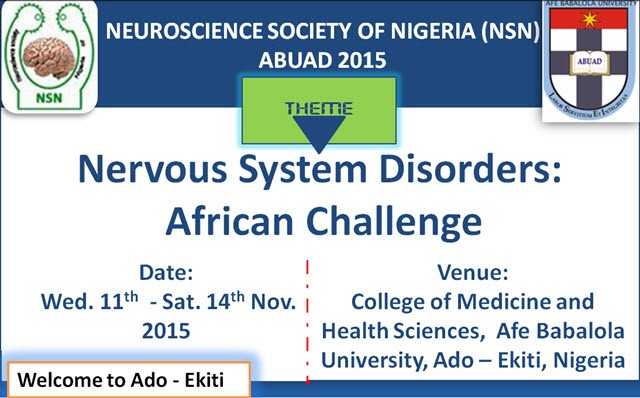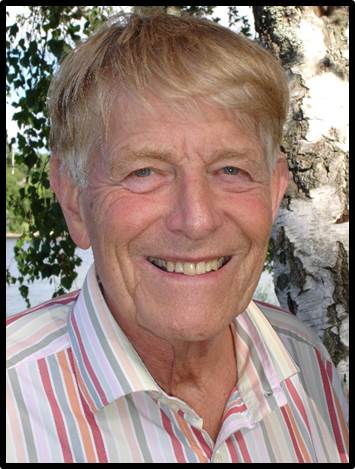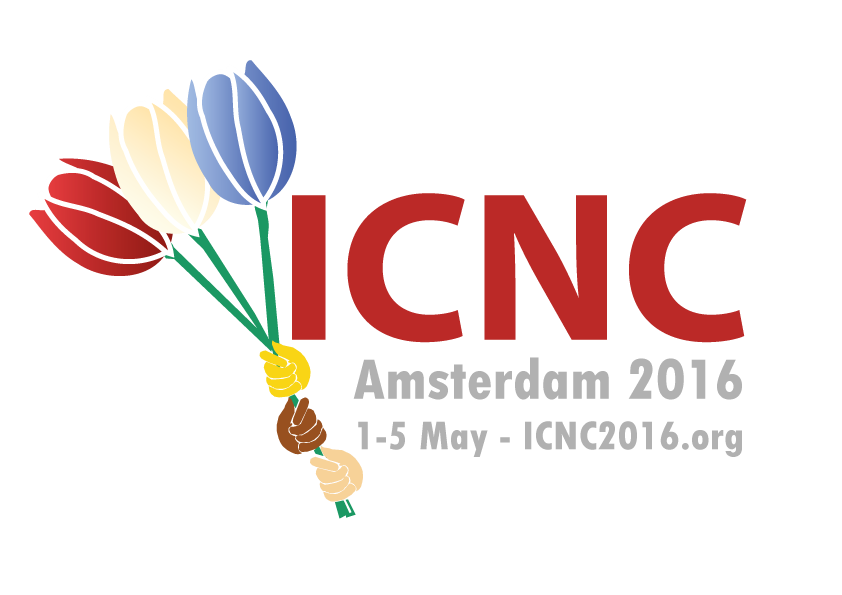
- Details
- ICNA
- News
- Hits: 696
The 13th Nigeria Society of Neuroscience (NSN) Conference will be held in AFE BABALOLA UNIVERSITY ADO EKITI (ABUAD) in from 11-14 November 2015. The theme of the conference is "Nervous system disorders: African Challenge".
The venue of the meeting is the College of Medicine and Health Sciences, Afe Babalola University, Ado-Ekiti, Nigeria. Ado Ekiti is a a city in southwest Nigeria, the state capital and headquarters of the Ekiti. It is also known as Ado. The people of Ado Ekiti are mainly of the Ekiti sub-thnic group of the Yoruba. Ado Ekiti city has a state owned university, the University of Ado Ekiti, now Ekiti state university, Ado-Ekiti, a privately owned University. The Afe Babalola University, Ado-Ekiti, a Polytechnic- the Federal Polytechnic, Ado-Ekiti. Various commercial enterprises operate in Ado Ekiti. The city is the trade centre for a farming region where yams, cassava, grain and tobacco are grown. Cotton is also grown for weaving..
Call for abstracts
Submission of abstracts opens April 1, 2015 and closes October 30, 2015. Submitted abstracts should not exceed 300 words and must include Background, Aims and Objectives, Methodology, Results and Conclusion. A maximum of three relevant references should also be included. Please send your abstracts to This email address is being protected from spambots. You need JavaScript enabled to view it.
| Categories | Early Registration | Late Registration |
| Undergrad students |
N1,500.00 |
N2,500.00 |
| Postgrad students | N8,000.00 | N10,000.00 |
| Professionals | N20,000.00 | N25,000.00 |
Local Organising Committee
Chairman
Laofe Ogundipe
+2349035210992
This email address is being protected from spambots. You need JavaScript enabled to view it.
Secretary
Babwale Olatunji
+2348065302521
This email address is being protected from spambots. You need JavaScript enabled to view it.
Scientifc Subcommittee Chair
Olalekan Ogundele
+2348153324284
This email address is being protected from spambots. You need JavaScript enabled to view it.
Media & Pub. Subcommittee Chair
Philip Adeniyi
+2348032922323
This email address is being protected from spambots. You need JavaScript enabled to view it.
Read More

- Details
- ICNA
- News
- Hits: 651
Professor Helen Cross, Executive board member of the ICNA, The Prince of Wales's Chair of Childhood Epilepsy, Deputy Head of Developmental Neurosciences Programme of the UCL Institute of Child Health and Honorary Consultant in Paediatric Neurology at Great Ormond Street Hospital NHS Trust, London and Young Epilepsy, Lingfield, received an OBE (Officer of the Most Excellent Order of the British Empire) in the Queen of England's Birthday Honours for her services to Children with Epilepsy.
Professor Cross said
Huge progress has been made in the diagnosis and management of epilepsy over the past 20 years. This has required national and international collaboration, as well as constant translation to clinical practice. This award is a great honour, and which I dedicate to all the children with epilepsy with whom I have had contact over the years, who continue to teach us so much more and for whom we strive for better outcome".!
Professor Cross has published widely on seizure, neuropsychological and behavioural outcomes in children who have undergone surgical resection for treatment of their epilepsy.
Her research has focused on improving outcomes for children with early onset epilepsy. Her early research was into improving imaging techniques to determine areas of likely seizure onset in children with drug resistant focal epilepsy and has developed an epilepsy surgery programme based on her research.
She conducted the first randomized controlled trial of the ketogenic diet in the treatment of children with drug resistant focal epilepsy and is endeavouring to conduct the same in the very young and adults. Recognising there was little in the way of control data with regard to neurodevelopmental progress, she initiated the North London Epilepsy in Infancy study, where a cohort of children was recruited at diagnosis in the first two years of life, and has been followed to at least three years. She is now aiming to conduct a similar study over a wider geographical area, also examining phenotypes and genotypes.
Read More

- Details
- ICNA
- News
- Hits: 676
IBRO-UCT African Advanced School on Epilepsy
Cape Town, South Africa
December 2 - 16, 2015
Organizer: Prof. Dirk Lang (University of Cape Town).
Aims and Scope of the School
This advanced school aims to provide advanced research training in both clinical and basic aspects of epilepsy.
Description
The main objective of the IBRO Advanced School on Epilepsy is to provide a platform for junior researchers, postdoctoral fellows and senior PhD students to gain knowledge and experience in the use of advanced neuroscience techniques in clinical diagnosis and electrophysiology. The aim is also to promote collaboration across the continent of Africa and beyond to enhance the level of expertise in the neurosciences. The School will include lectures on state-of-the-art techniques as well as lectures aimed at providing a deeper understanding of e.g. the pathogenesis of epilepsy, the role of surgery in epilepsy, the effect of antiepileptic drugs on behaviour and cognitive function in patients with epilepsy. The basic aspect of the school will provide training in methods aimed at understanding seizures and epilepsy at multiple levels from genes to networks. This includes molecular methods, in vitro recording of seizure-like activity, whole cell-patch clamp, immunohistochemistry and calcium imaging.
Who should apply to this School?
Application is open to PhD & MD students, post-doctoral fellows & junior faculty engaged in clinical and/or basic research pertaining to epilepsy and are currently residing in Africa. Applicants will be selected on the basis of their CVs. Consideration will also be given to ensure participation of trainees from different parts of Africa.
What costs will be covered for selected applicants?
Accommodation and meals will be provided. Assistance with travel expenses to South Africa will be available if required and adequately motivated.
Application deadline: July 1, 2015 (11:59 p.m. CET)
Apply here
For all enquiries, please contact Prof. Dirk Lang at This email address is being protected from spambots. You need JavaScript enabled to view it.
Co-sponsored by Society of Neuroscientists of Africa
The ICNA is not affiliated with the International Brain Research Organization (IBRO)
Read More
- Details
- ICNA
- News
- Hits: 656
 The ICNA is delighted to congratulate Professor Orvar Eeg-Olofsson on being named as a Honorary Member of the European Paediatric Neurology Society. Honorary membership of the EPNS is the highest distinction for paediatric neurologists who really advanced the field of pediatric during their career. This can be at all levels that are important in the spirit of the EPNS : advancements in research , excellent clinical care and / or educational qualities. More importantly, honorary EPNS members continue to sympathize with our goals and are actively involved in promoting EPNS.
The ICNA is delighted to congratulate Professor Orvar Eeg-Olofsson on being named as a Honorary Member of the European Paediatric Neurology Society. Honorary membership of the EPNS is the highest distinction for paediatric neurologists who really advanced the field of pediatric during their career. This can be at all levels that are important in the spirit of the EPNS : advancements in research , excellent clinical care and / or educational qualities. More importantly, honorary EPNS members continue to sympathize with our goals and are actively involved in promoting EPNS.
Professor Orvar Eeg-Olofsson was born in 1932 in Sweden and had his training in Sweden. He was the head of paediatric neurology in Upssala Sweden and is now Senior Professor at the same university. He was a board member in the early days of the EPNS. He is an expert in EEG, neurophysiology and epilepsy. He was involved in many educational activities for EPNS and ICNA throughout the world: a real sailing man.
Prof Eeg-Olofsson was also the Chairman of Swedish Child Neurology Association 1994-1996; Board member of European Paediatric Neurology Society (EPNS) 1997 - 2005.; Board member of ICNA since 1998 (Treassurer 2002 - 2010 and re-elected 2010 - 2014) and Member of the ILAE task force group on classification 2000-2005.
Read More

- Details
- ICNA
- News
- Hits: 589
We kindly invite you to submit proposals for lunch symposia, covering specialized child neurology topics, for the 14th ICNC 2016, in Amsterdam.
The congress theme is "Bridging Worlds; Child Neurology from a Global Perspective"
These symposia will enable a group of expert speakers to present current knowledge or new developments in well delineated areas of pediatric neurology in depth, reaching a targeted audience. Sessions will last 90 minutes, including a short introduction by the chairperson and 3 presentations – 20 minutes each – with ample time for interactive discussion. On choosing speakers, consideration should be given to geographical representation. Presentations are expected to comprise not only high-tech advances in the field, but also clinically relevant aspects of global importance. Proposals for symposia covering international collaborative research networks are particularly welcome.
Chairpersons should realize that the organizing committee unfortunately cannot waive registration fees, nor reimburse travel or accommodation expenses, for symposium speakers. It is therefore advised that proposers of symposia should check that speakers are willing to be put forward on this basis.
Please submit your proposal online (http://icnc2016.org), including the names and affiliations of chairperson(s) and three speakers, the title of their presentations, as well as a short summary of the session. The deadline for submission is August 1st 2015.
We look forward to your proposals and hope to welcome you all in Amsterdam, for the 14th ICNC, May 1st- 5th 2016.
On behalf of the organizing and scientific committees,
Michèl Willemsen
Chair of the ICNC 2016 scientific committee
Helen Cross
Chair of the ICNA scientific committee
Kees Braun
Chair of the ICNC 2016 organizing committee
Read More